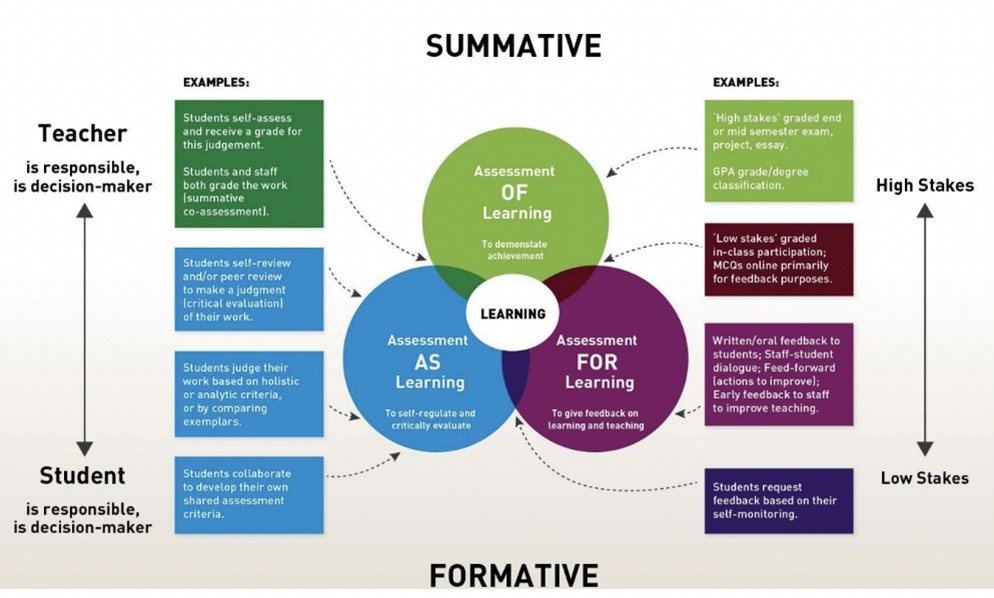Home » Administration » Academic Affairs and Registrar » UDL » Applying UDL » Assessments and Feedback
Assessments and Feedback
Three primary principles of UDL, which are based on research in the learning sciences, guide UDL. These principles can be helpful in thinking about the design of assessments.
The following is from the CAST Organization UDL on Campus assessment resource:
Providing multiple means of engagement (the why of
learning) means supporting interest, motivation, and persistence. Just as
students learn more effectively when they are engaged and motivated, their
performance on assessments can be enhanced by increasing engagement.
·
Do students think that they can be successful? Emphasizing
the importance of effort and motivation and expressing confidence that students
can meet high expectations can improve their performance.
·
Do assessments provide different levels of challenge? One
way to do this is to provide options on essay exams so that students can choose
a question they feel they can answer well. Another way is to allow
students to answer essay questions in different formats. Perhaps students
could write a classic essay, create a short play, or create a video
response. Once an instructor has addressed the question, “What do I
really want the learner to learn?” (i.e., construct relevance) then the
individual motivations and desires of learners and the time constraints of
their instructors may be the only limits to the possibilities.
·
Are different formats used for assessments over the course of a
semester? As mentioned earlier, the demands and benefits of any one form
of assessment will differ for each student. Therefore, the options and
supports provided for the first two UDL principles (representation and action and expression)
can enhance engagement in the assessment process.
Read more aboutincluding UDL in assessment from the CAST Organization.
The following is from the CAST Organization UDL on Campus assessment resource:
Providing multiple means of action and expression (the how of
learning) means providing different ways for students to work with information
and content and to demonstrate what they are learning.
In assessment, consider the ways in which students will demonstrate
what they have learned.
·
Will they need to write or draw?
·
Will they demonstrate an action?
·
Do they need to organize information mentally, or can something
be provided to help them organize the information (e.g., concept mapping
software)?
Again, consider which actions are actually relevant to the
construct being measured and which ones can be supported or varied in order to
gain an accurate picture of what each student has learned.
Read more aboutincluding UDL in assessment from the CAST Organization.
The following is from the CAST Organization UDL on Campus assessment resource:
Providing multiple means of representation (the what of
learning) means presenting information and content in different ways and making
connections between them. When planning assessments, consider the ways in
which the items are presented—text, graphs, charts, images, videos, demonstrations,
objects to manipulate.
·
Do the ways in which items are presented create barriers for any
students?
·
Are there alternatives that could be used that would still allow
accurate assessment of what students should know or be able to do?
·
Are the representations used construct relevant? For example, if
students need to be able to interpret information in graph format, then the
graph itself is relevant. If they only need to be able to use the
information in the graph, consider providing different formats for displaying
the information. Tables, charts, infographics, or even plain text may be a
more accessible format for some students. Remember, the goal is to find
out what students are learning. Keep in mind basic accessibility
requirements for images (including images of tables, charts, and
graphs). Any text in an image needs to be readable by a computer or other
assistive device that a student might need for access. All images should
have alt text. Additionally,
a long description is
needed when an image is complex and cannot be described briefly.
Read more aboutincluding UDL in assessment from the CAST Organization.
The Learner Oriented Framework for Assessment (LOA) provides a more holistic perspective that places student growth at the center. It is not about testing or catching a student out, rather, it is about developing skills. It breaks down assessments into three functions: for learning, as learning, and of learning:

Allowing learners opportunities to provide and receive feedback to their peers has been shown to have significant impacts on student learning, engagement, and self-concept. It is a more authentic experience and provides students a chance to practice skills that they will use throughout their careers. This will help students become lifelong learners. To do this well, students need guidance such as rubrics, modelling, and explicit explanations about the rationale. Also, be upfront with students about how messy the process can be and connect this to the idea of developing 21st century skills.
Rubrics are powerful tools to aid students throughout their assessments. A good rubric should outline clearly how a learner can demonstrate mastery of a concept and can help them manage their time. A rubric from a UDL lense should include the following characteristics:
- It should be provided to students when the assessment is assigned and the criteria should be explained clearly – allow time for questions and feedback
- It should measure how the student is demonstrating their understanding of the learning objective – not how they are demonstrating it
- Rubrics should allow for multiple forms of submissions – there should be no need to create multiple rubrics for the same assignment. For example, if your rubric stipulates clear “spelling and grammar,” you change this to “communication is clear and free of major errors.” This allows for video, audio,written, or other mediums for submission.
Here is an example of how a rubric can be used to guide learning rather than simpling measuring it.